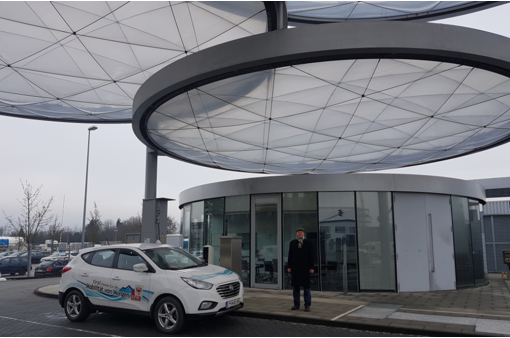Linde hydrogen refuelling stations #HydroChan
On 3 February 2017, Mortimer Schulz, the founder and owner of solutions in energy e.U., drove from Innsbruck to Munich to increase learning experience about HRS on the occasion of three stations with Linde technology in Munich Detmoldstrasse, Carl-von-Linde Strasse and Innsbruck Andechsstrasse.

Innsbruck
The journey began in Innsbruck at 08:20 in the morning in a Hyundai ix35 FCEV. At freezing temperature, the A12 Inntal-Autobahn was taken, continuing on North from Schwaz, TYROL via Achensee, across the Austro-German border to Tegernsee, BAVARIA following national routes B308/ B312 and arriving at Munich Detmoldstrasse HRS (TOTAL), near the BMW testing facility at 10:40.
Munich Detmoldstrasse
Two gentleman of Linde AG kindly presented the hydrogen storage of a suburban 10,000 litre liquid hydrogen storage tank, with external hydrogen production and delivered there by a liquid hydrogen storage truck on regular basis. The hydrogen is kept at minus 253° degree Celsius, and can be either pumped cryogenically to deliver minus 220° degree Celsius at 350 bar, or “heated” to minus 30° to minus 40°-degree Celsius which I use to refuel the hydrogen into the FCEV at 700 bar.
Munich Linde Hydrogen Center
Further, actual gaseous hydrogen refuelling of 390 bar, thus leading to 740 bar, took place at 12:15.
For the last 10 years, the Linde Hydrogen Center has been supplying liquid hydrogen LH2 and gaseous hydrogen GH2 at this state-of-the-art Hydrogen Refuelling Station, Test Centre and Exhibition Venue in a 3-in-1 concept with futuristic architecture. Since January 2017 it is open to the public and I refuelled with a CEP-card. The Centre is located next to the Gases Division of Linde AG.
Return trip from Munich to Innsbruck
Via A8 and A93, at 17:30 Innsbruck Andechsstrasse (OMV) was reached and 200 bars GH2 were refuelled to yield 740 bar, giving a range of 542 km. 436 km total were driven; at minus temperatures.
The social media channel www.facebook.com/solutionsinenergy/ refers. Please look up for details.
FCEV driving experience
Driving the Hyundai ix35 FCEV for meanwhile more than 7,000 kilometres, one of the open issues was still the Eco (E)-drive mode vs. the Drive (D)-drive mode. With “E” the acceleration is less than with “D”, and therefore the hydrogen consumption is slightly less (under 1 kilogram hydrogen per 100 kilometres), while with “D” slightly more than 1 kg H2/100km. In the mountains of Tyrol and Bavaria, on national routes, driving in “D” for a short while to climb up quickly was probably more efficient, and then switching to “E” on even roads for cruising (as previously pointed out by a gentleman from Hyundai Norway during the Hydrogen Challenge #2.0 Bergen-to-Bolzano 2,316 km in June 2016).
HYDROGEN REFUELLING STATIONS
For any information not correct or changed, please let Mortimer #HydroChan kindly know.





